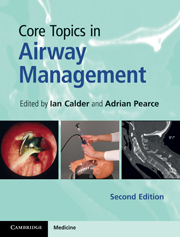
-
Select format
-
- Publisher:
- Cambridge University Press
- Publication date:
- January 2011
- December 2010
- ISBN:
- 9780511760310
- Dimensions:
- Weight & Pages:
- Dimensions:
- Weight & Pages:
You may already have access via personal or institutional login
Book description
Every anaesthetist reaches the end of their career with a collection of difficult airway experiences. Managing airway challenges relies on a combination of good clinical practice, knowledge of relevant basic sciences and critical evaluation of every aspect of airway care. This new edition of Core Topics in Airway Management provides any trainee or consultant involved in airway techniques with practical, clinically relevant coverage of the core skills and knowledge required to manage airways in a wide variety of patients and clinical settings. All new procedures and equipment are reviewed, and detailed chapters advise on airway issues in a range of surgical procedures. This edition also contains a series of practical questions and answers, enabling the reader to evaluate their knowledge. Written by leading airway experts with decades of experience managing difficult airways, Core Topics in Airway Management, 2nd edition is an invaluable tool for anaesthetists, intensivists, and emergency physicians.
Reviews
Review of the first edition:‘Core Topics in Airway Management concisely covers all the basics and some of the unique areas in airway management … Key, groundbreaking, clinically relevant material is presented in a clear and succinct manner, with salient points bulleted at the end of each chapter along with further reading suggestions … In summary, Core Topics in Airway Management is exactly what it says it is, a textbook that provides succinct and useful information on airway management that is required by a wide spectrum of health care professionals, independent of the reader's medical discipline or training level. This text provides a foundation for the multispecialty approach to airway management. Readers are offered an easy to read book on airway management, containing many pearls of practical wisdom.'
Carin Hagberg Source: Anesthesia and Analgesia
'I was impressed with the review of physiology and the willingness of editors and authors to describe areas of controversy in acute airway management … an excellent introduction to a central topic in anesthesiology and acute medicine.'
Source: Doody's Notes
Contents
Metrics
Altmetric attention score
Full text views
Full text views help Loading metrics...
Loading metrics...
* Views captured on Cambridge Core between #date#. This data will be updated every 24 hours.
Usage data cannot currently be displayed.
Accessibility standard: Unknown
Why this information is here
This section outlines the accessibility features of this content - including support for screen readers, full keyboard navigation and high-contrast display options. This may not be relevant for you.
Accessibility Information
Accessibility compliance for the PDF of this book is currently unknown and may be updated in the future.


